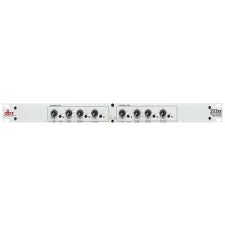To find out more about our DBX Stereo 2 Way Crossover
Enquire Now
The DBX Stereo 2 Way Crossover is the secret to making speakers sound great. This unit, the DBX 223XL Crossover, gives great performance, low noise and reliability – unsurprising when it is made by DBX who are known for building the world’s best audio processors.
This audio processor is a dual channel crossover and has a range of useful features – Linkwitz-Riley 24dB per octave filters, independent output gain controls for level matching, output phase inversion, 40 Hz low cut filter, and optional mono summing of the low frequency (subwoofer) output.
Choose whether you want to operate your system in stereo 2-way or mono 3-way then set whether you want to mono sum the LF (subwoofer) out. On the front panel there are LEDs that indicate whether the unit is in mono or stereo mode. Back panel switches allow you to select the range of the crossover frequencies individually for both channels.
All the inputs and outputs on the DBX 223xl processor are balanced XLRs that are screwed directly to the chassis. This connection of the jacks to the chassis insures that even if someone stomps on a cable plugged into the unit, it’s not going to tear up the circuit board inside. The crossover frequency controls have a green LED that indicates when the x10 switch on the back panel is activated. All the switches are on the back panel because it could be disastrous if you were to change them mid-program.
Each channel has an input gain control for proper level setting. There’s a recessed 40 Hz low cut (HPF) on each channel to remove unwanted low frequencies. Both the low and high outputs on each channel have a gain control ranging from -infinity to +6 dB to allow muting of individual outputs and for level matching. Also, these outputs each have phase reverse switches that will help get you out of a bind without having to reconfigure your system. These phase reverse switches may be internally reconfigured as mute switches.
Product Description
The DBX Stereo 2 Way Crossover is the secret to making speakers sound great. This unit, the DBX 223XL Crossover, gives great performance, low noise and reliability – unsurprising when it is made by DBX who are known for building the world’s best audio processors.
This audio processor is a dual channel crossover and has a range of useful features – Linkwitz-Riley 24dB per octave filters, independent output gain controls for level matching, output phase inversion, 40 Hz low cut filter, and optional mono summing of the low frequency (subwoofer) output.
Choose whether you want to operate your system in stereo 2-way or mono 3-way then set whether you want to mono sum the LF (subwoofer) out. On the front panel there are LEDs that indicate whether the unit is in mono or stereo mode. Back panel switches allow you to select the range of the crossover frequencies individually for both channels.
All the inputs and outputs on the DBX 223xl processor are balanced XLRs that are screwed directly to the chassis. This connection of the jacks to the chassis insures that even if someone stomps on a cable plugged into the unit, it’s not going to tear up the circuit board inside. The crossover frequency controls have a green LED that indicates when the x10 switch on the back panel is activated. All the switches are on the back panel because it could be disastrous if you were to change them mid-program.
Each channel has an input gain control for proper level setting. There’s a recessed 40 Hz low cut (HPF) on each channel to remove unwanted low frequencies. Both the low and high outputs on each channel have a gain control ranging from -infinity to +6 dB to allow muting of individual outputs and for level matching. Also, these outputs each have phase reverse switches that will help get you out of a bind without having to reconfigure your system. These phase reverse switches may be internally reconfigured as mute switches.





